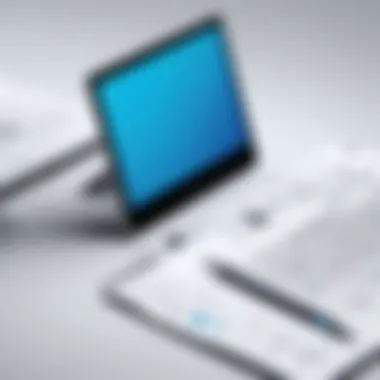The Smartpen Revolution: Writing on Any Paper


Intro
The rise of smart technology has revolutionized many aspects of daily life, including writing. Smartpens have emerged as a groundbreaking tool that bridges the gap between traditional handwriting and digital convenience. This article delves into the nuances of smartpens that work seamlessly on any paper, highlighting their key features, specifications, functionality, and overall impact on productivity and creativity. By understanding these devices, both professionals and students can better evaluate their potential benefits and challenges.
Key Features
Smartpens hold unique advantages over traditional writing tools. They combine conventional penmanship with advanced technology, making them versatile and functional. Below are some essential attributes that contribute to their popularity:
- Enhanced Writing Experience: Smartpens allow users to write naturally while capturing every stroke accurately. With pressure sensitivity and smooth glide, these devices offer a tactile experience akin to traditional writing instruments.
- Storage and Transfer Capabilities: Many models come with built-in memory, enabling users to store numerous pages of notes. Data can be easily transferred to devices like tablets or smartphones via Bluetooth or USB connections, simplifying the process of digital documentation.
- Integration with Apps: A significant advantage of smartpens is their compatibility with various note-taking applications. Users can organize notes, add voice recordings, and even search handwritten text through specialized software.
Design and Build Quality
Smartpens are often designed with ergonomics in mind, ensuring comfort during extended use. They tend to have a sleek and modern appearance that appeals to tech-savvy individuals. Materials can vary, but premium models often feature durable casings that withstand daily wear and tear. Some devices even offer customizable options, allowing users to select colors or finishes that best reflect their personal style.
Display and Performance
Performance can greatly influence a user’s experience with a smartpen. While some models include an LED display for notifications and battery life monitoring, many rely solely on the app for information. Overall, a reliable smartpen should provide an uninterrupted writing experience, allowing users to focus on their notes without technical issues.
Product Specifications
Understanding the technical details helps users make informed decisions when selecting a smartpen. Here are key specifications to consider:
Technical Specifications
- Battery Life: Depending on usage, battery life can vary significantly. Most smartpens provide several hours of continuous use, with options for quick charging.
- Resolution: The precision of digitized handwriting is vital for accuracy. Higher-resolution models capture finer details, enhancing the legibility of handwritten notes.
- Weight and Size: An ideal smartpen should balance weight and portability, ensuring ease of carrying.
Compatibility and Connectivity
Smartpens generally support a range of operating systems, including iOS and Android. Compatibility with popular note-taking apps like Evernote or Microsoft OneNote can provide users with flexibility in how they manage their information. Connectivity options such as Bluetooth and USB-C enable efficient data transfer between devices, streamlining the workflow.
"Smartpens embody the fusion of traditional and modern writing, catering to the needs of today's fast-paced, technology-driven world."
In summary, smartpens present a compelling alternative to traditional writing tools. Their ability to effortlessly transition from paper to digital allows users to enhance their organizational skills and improve productivity.
As the demand for such innovative tools continues to grow, it's essential for potential buyers to consider their specific needs and preferences before making a purchase.
Preamble to Smartpens
In today's fast-paced environment, the tools we use for writing have evolved significantly. Smartpens represent a notable leap in this evolution. These devices combine traditional writing methods with advanced digital technologies. Understanding what smartpens are and how they function is crucial for anyone interested in productivity tools or learning technologies.
Definition and Overview
Smartpens are innovative writing instruments equipped with various technologies that capture handwritten notes and convert them into digital form. They usually feature built-in sensors, microphones, and software that facilitate this conversion, allowing notes written on any paper to be saved and shared electronically. The appeal of smartpens lies in their ability to blend the tactile experience of pen and paper with the convenience of digital storage and organization.
Benefits of Smartpens:
- Enhanced Note Management: Users can organize their notes more efficiently, reducing clutter and improving accessibility.
- Versatility: They can work on different types of paper without requiring a special notepad, making them adaptable for various settings.
- Real-Time Capture: Smartpens often enable immediate digital capturing of notes, ensuring that valuable information is not lost.
Despite their advantages, it's essential to consider a few factors when exploring smartpens. The initial cost might be higher than traditional pens. Additionally, users may face a learning curve while adapting to the features and technology involved. Nonetheless, the potential for enhancing efficiency and creativity makes smartpens an interesting tool for modern learners, professionals, and creative individuals.
"The smartpen represents a convergence of traditional practices with the digital age, offering a unique solution for both writing and organizing information effectively."
There is much to uncover about smartpen technology, including how they operate, their advantages, and their application across various fields. This article will provide an in-depth exploration of these aspects, ensuring a comprehensive understanding of the smartpen phenomenon.
How Smartpens Work
Understanding how smartpens function is crucial to appreciating their role in modern writing. These devices blend traditional writing methods with advanced technology. This section will elaborate on the components that enable smartpens to capture and digitize handwritten notes effectively. It will also examine how these tools connect with digital devices for an enhanced user experience.
Technological Components
At the heart of every smartpen are several key technological components. The most significant include:
- Sensors: These specialized devices detect pen movements and convert them into digital data. They track the detailed position of the pen on paper.
- Camera: Some smartpens feature a small camera that captures text and images simultaneously. This enhances data capture, especially for diagrams or sketches.
- Microphone: Audio-recording capabilities accompany many smartpens. A microphone allows users to record audio synchronized with their notes, providing context at a later time.
- Memory Module: Smartpens typically have internal storage for saving data before uploading it to a connected device.
- Battery: An essential component, the battery powers the device for extended periods, enabling users to write freely without concerns about energy depletion.
The synergy among these components defines the smartpen's usability. Without these technologies, the seamless integration of handwritten notes into the digital realm would be impossible.
Integration with Digital Devices


The ability of smartpens to communicate with digital devices is also essential. This integration expands the functionality and usefulness of smartpens significantly. Key points in this regard include:
- Bluetooth Connectivity: Most smartpens utilize Bluetooth technology to connect to smartphones, tablets, or computers. This wireless approach facilitates instant syncing of notes.
- Dedicated Apps: Many smartpens come with specific applications that enhance users' interaction with their notes. These apps often support features like uploading to cloud storage or organizing notes.
- File Formats: Smartpens allow users to save their work in various formats. Typical choices include PDF and JPEG, which enable easy sharing and review of handwritten content.
- Cross-Platform Compatibility: Users can often switch between devices, accessing their notes from android or iOS platforms. This flexibility increases the value of smartpens in professional or academic settings.
Achieving a seamless connection is vital, allowing users to harness the advantages of digital storage while retaining the tactile experience of writing. Therefore, exploring the technological components and their integration with devices is essential to understanding the overall impact of smartpen technology in today's fast-paced world.
Advantages of Smartpens
The advent of smartpen technology has transformed traditional writing practices, offering numerous advantages that enhance user experience. These pens are not just tools; they are bridges between the physical and digital worlds, providing benefits that appeal to a wide audience, including students, professionals, and creative individuals. The versatility, improved note-taking capabilities, and ease of editing foster a significant shift in how individuals approach writing and documentation.
Versatility with Writing Surfaces
Smartpens can operate on various writing surfaces, allowing users to write on any paper without any obstacles. This feature is essential in environments where different forms of paper are present, such as in schools or offices. Users do not need to purchase special notebooks or pads. Instead, they can utilize ordinary paper, making smartpens more accessible and convenient.
This adaptability promotes creativity. For instance, artists can sketch on standard sheets while benefiting from the smartpen's digital capabilities. Similarly, business professionals can jot down notes during meetings on any available paper, ensuring that important information is captured regardless of the writing medium.
Enhanced Note-Taking Capabilities
One prominent advantage of smartpens is their ability to elevate note-taking practices. The technology allows users to record audio while writing, linking spoken words to written notes. This feature is invaluable for students attending lectures or professionals in meetings where details matter. Users can refer back to specific moments in the audio recordings by tapping the corresponding part of their notes, creating a synchronized and comprehensive documentation experience.
Moreover, with handwriting recognition software, notes taken with smartpens can be converted to digital text. This conversion streamlines the process of organizing and sharing information, reducing the time spent manually typing out handwritten notes. Reducing redundancy increases productivity in both academic and professional settings.
Ease of Annotation and Editing
Smartpens facilitate easy annotation and editing of notes, a significant asset for those involved in collaborative work or study. Users can digitally annotate their handwritten notes, enhancing clarity without needing separate documents. This feature is particularly useful for students during group projects or professionals who need to leave feedback on shared documents.
Another benefit of smartpens lies in their ergonomic designs. They are typically lightweight and easy to grip, minimizing fatigue during extended writing sessions. This comfort ensures that users can focus on their tasks rather than being distracted by discomfort.
The ability to easily annotate and edit notes allows users to maintain organized, accurate records at all times. This contributes to reducing time spent on rearranging and correcting notes.
Applications Across Different Fields
The advent of smartpens has ushered in significant changes across multiple sectors. Their ability to bridge the gap between analog and digital environments enhances productivity in ways traditional writing tools often cannot. Smartpens offer versatile functionalities that cater to the needs of diverse fields ranging from education to business and creative industries. Understanding these applications provides insight into how smartpens can transform specific tasks and workflows, leading to more efficient and effective outcomes.
Education and Learning
In educational settings, smartpens have proven to be invaluable tools. They not only allow students to transcribe notes seamlessly but also enhance the learning process by integrating audio recordings. This feature permits students to capture audio while writing, enabling them to revisit lectures alongside their notes. An important aspect is the ability to digitize written materials, which makes sharing and organizing information straightforward for students and educators alike. Furthermore, the interactive nature of smartpens aids various learning styles, particularly kinesthetic learners who benefit from the physical act of writing.
- Some key benefits in education include:
- Real-time audio capture during lectures helps reinforce learning.
- Simplified sharing of notes enhances collaboration among students.
- Digital archiving allows for organized future reference, ensuring information is easily accessible.
Business and Professional Use
Businesses are increasingly recognizing the efficiency that smartpens bring to professional settings. From meetings to brainstorming sessions, these devices allow professionals to annotate documents, capture meeting notes, and even sign contracts directly. The integration with digital platforms gives teams the capability to synchronize notes instantly, ensuring that essential information is not lost amid chaotic meetings. Moreover, smartpens facilitate the transition from digital documentation to physical signatures which can streamline workflows.
- Important considerations in professional use include:
- Time-saving features, enabling quicker documentation.
- Enhanced team collaboration through shared digital notes.
- Reduced administrative tasks due to the easy organization of information.
Creative Industries
In creative domains, particularly in design and illustration, smartpens serve both as tools for expression and as instruments of precision. Artists and designers leverage these devices to create sketches that can be instantly transformed into digital formats. Furthermore, the tactile feedback of writing with a smartpen retains the essence of traditional drawing, while simultaneously offering the digital benefits that come with modern design software integration. This fusion of physical and digital mediums broadens the possibilities for creative projects.
- In creative industries, smartpens enhance productivity by:
- Allowing immediate digital conversion of traditional sketches.
- Facilitating collaborative design efforts with easy sharing capabilities.
- Reducing repetitive tasks by combining sketching with digital editing tools.
Overall, the applications of smartpens in various fields highlight their significance. They redefine productivity and creativity, offering tailored solutions that meet specific industry needs. As technology continues to evolve, the role of smartpens in enhancing workflows will only grow.
Challenges and Considerations
Understanding the challenges and considerations when utilizing smartpens adds depth to the discussion of their advantages. While smartpens provide innovative solutions for writing on paper, a few factors can influence their effectiveness and user experience.
Learning Curve
The learning curve associated with smartpens can be significant for new users. Unlike traditional pens, smartpens often come with unique functionalities, such as pairing with apps and utilizing varied writing styles. Users might need time to familiarize themselves with the technology. The interaction between the pen and the paper it writes on can also differ. Users may find themselves struggling with calibration or compatibility issues.
Many manufacturers provide tutorials and user guides. These resources are vital for helping users adapt quickly. Success in overcoming the learning curve can lead to a higher level of efficiency and satisfaction in note-taking and writing tasks.


Battery Life and Maintenance
Battery life is another critical factor. Smartpens depend heavily on battery power, which limits their usability. Generally, these devices can last for a week or more on a single charge, depending on usage. However, frequent usage may require more regular recharging, which can be inconvenient for on-the-go writing.
Additionally, maintenance plays a role in the long-term effectiveness of smartpens. Users need to clean the pen tip and ensure it functions correctly. Some models may require software updates to enhance their capabilities. Regular maintenance helps avoid performance degradation over time and ensures that the device operates smoothly.
Cost Analysis
Cost presents another important consideration. Smartpens generally come with a higher price tag than traditional writing instruments. This expense can deter potential users. However, when weighing the cost against benefits such as digital connectivity, cloud storage for notes, and enhanced productivity, potential savings may become apparent.
Budgeting for a smartpen involves assessing individual needs. Users should look at several aspects:
- Initial purchase price
- Possible subscription fees for additional features or services
- Replacement costs for ink cartridges or paper used with certain smartpen models
Purchasing a smartpen can be seen as an investment in personal or professional efficiency. Careful analysis can help determine if the benefits justify the cost for each user.
A thorough understanding of these challenges can lead to better decision-making when choosing a smartpen. Users should weigh the learning curve, battery life, maintenance needs, and initial costs before making a commitment.
By addressing these challenges, individuals can optimize their use of smartpen technology and enhance their writing experiences.
User Experience and Feedback
The importance of user experience and feedback cannot be overstated when it comes to smartpen technology. These devices are designed to simplify the writing process and improve productivity. Users who engage with smartpens often contribute valuable insights that help makers refine their offerings. This section examines the elements that shape user experience.
Comparative User Studies
User studies comparing different smartpen models can reveal important patterns and preferences. Research often emphasizes portability, reliability, and ease of use as key factors in user satisfaction. For instance, a recent study conducted across various educational settings highlighted the remarkable value of smartpens in note-taking. Participants felt that the ease of syncing notes between devices enhanced their overall learning experience.
Data from these studies often show that users prefer smartpens with longer battery life, better connectivity options, and efficient software features. Features such as voice recording and synchronization with various applications also influence user satisfaction significantly.
In educational contexts, students showed a preference for models that integrate seamlessly with tablet devices, which provides them flexibility during classes. Users in professional environments, on the other hand, often prioritize advanced features such as customizable shortcuts for quicker access to notes. These studies extract common themes and form a more complete picture of user expectations, contributing to improved designs and functionality in future smartpen models.
User Testimonials
User testimonials provide another dimension to understanding smartpen technology. They offer authentic insights into the practical benefits and any limitations users have encountered. Many individuals report that smartpens have transformed their writing habits, allowing them to maintain clarity and organization in their notes.
For example, a user named Sarah, a graduate student, shared how her smartpen helped her to retain important information during lectures. She noted, "I no longer worry about losing written notes. The ability to turn my handwritten notes into editable text has changed how I study."
Conversely, some users express frustration regarding the learning curve associated with new features. This feedback is crucial for manufacturers. Smartpen developers can address these issues by creating more intuitive interfaces or incorporating better tutorials into their software.
User feedback is also vital for sustaining brand loyalty. When companies respond to customer suggestions and complaints, they enhance user satisfaction and build trust.
"User experience should inform every facet of smartpen development, from design to functionality."
By focusing on user experience, smartpen technology can continue to evolve, bringing more efficient tools to those who seek enhanced productivity and better writing solutions.
Smartpens vs. Traditional Writing Tools
The debate between smartpens and traditional writing tools is essential for understanding how these two categories of writing instruments can coexist in today's tech-driven world. Smartpens offer unique integration with digital technology that enhances the writing experience. Traditional writing tools, such as pens and pencils, retain their charm due to their simplicity and straightforward functionality. As we evaluate these differences, we must delve into the functional comparisons and specific use cases of each tool to grasp fully the advantages and challenges they present.
Functional Comparisons
Smartpens and traditional writing tools differ mainly in their functionality. Smartpens record handwritten notes as digital files, enabling seamless integration with applications like Notability or Evernote. This means that what you write gets transformed into a digital format instantly, facilitating easier organization and retrieval later on. In contrast, traditional pens lack this capability.
- Smartpens:
- Traditional Pens:
- Digitize notes quickly.
- Allow for easy editing and sharing.
- Feature advanced functionalities like audio recording linked to handwriting.
- Provide tactile feedback while writing.
- Do not require batteries or charging.
- Can be used on any surface without specific requirements.
While smartpens may offer convenience, traditional tools appeal to those who prefer the actual feel of writing on paper. The choice often depends on individual preference rather than absolute superiority.
Use Cases for Different Tools
It is important to identify specific situations or environments where one tool might excel over the other. Smartpens find their strength mainly in educational and professional settings. For instance, students can use smartpens during lectures to record notes while also taking advantage of features that streamline their learning processes.
In contrast, professionals who engage in quick brainstorming sessions might still favor traditional pens. The ability to draft thoughts on paper quickly often leads to creativity that technology cannot replace.
Use Cases for Smartpens:


- Educational environments for note-taking.
- Meetings and lectures requiring audio notes.
- Creative professions where concept sketches are paired with written ideas.
Use Cases for Traditional Tools:
- Casual notes and reminders.
- Creative expression, like sketching or doodling.
- Environments with limited or no power sources.
In summary, the choice between smartpens and traditional writing tools depends on the user's needs and settings. Both tools have their unique benefits, and understanding these can help individuals make more informed choices.
Latest Innovations in Smartpen Technology
The realm of smartpen technology is evolving rapidly. As features and functionality expand, the significance of these innovations becomes apparent. Exploring the latest developments can illuminate the trajectory of smartpens and their integration into everyday life. This section aims to detail recent advancements, their implications, and what the future may hold for smartpens.
Recent Developments
In recent years, several advancements have taken place in the smartpen landscape. Manufacturers have introduced several noteworthy features. For example, the integration of Bluetooth connectivity has allowed smartpens to sync with smartphones and tablets more seamlessly. This means users can access their notes immediately on digital platforms, enhancing productivity. Another development includes improvements in data storage capacity, enabling users to save entire notebooks worth of notes without the fear of running out of space. This is particularly essential for professionals and students alike.
Furthermore, handwriting recognition technology has made impressive leaps. Modern smartpens can not only capture handwriting but can also convert it into editable text with increased accuracy. This feature has significant implications for users who prefer handwritten notes but require the convenience of digital text for easy sharing.
Additionally, we see approaches that integrate voice recording features into smartpens. This is beneficial for lectures or meetings, where users can record audio while writing down critical points. The combination of audio and text creates a rich resource for later review.
"The innovations in smartpen technologies redefine how we interact with written content, bridging physical and digital realms."
Predicted Trends
The trajectory of smartpen development shows promise for the future. Several trends are likely to shape the industry ahead. One inevitable trend is the increase in AI integration. As artificial intelligence continues to mature, smartpens may offer advanced predictive text features or contextual handwriting suggestions, making writing more intuitive.
Furthermore, we can expect to see a movement towards more ergonomic designs. Comfort is essential for long writing sessions, and manufacturers are likely to focus on developing designs that enhance usability without sacrificing style.
The potential for cloud integration is also evident. By linking smartpens with cloud services, users can access notes from anywhere with an internet connection. This enhances collaboration, particularly in business or educational settings.
Lastly, sustainability is becoming a focal point in technology. Future smartpens may explore using eco-friendly materials for production and offer functionalities that promote responsible recycling practices, resonating with the growing consumer preference for green technology.
As these innovations and trends unfold, the smartpen continues to solidify its role as a versatile tool in the modern writing experience.
Buying Guide for Smartpens
Purchasing a smartpen involves careful consideration of several factors intrinsic to its functionality and usability. This section addresses the critical aspects that potential buyers must take into account to ensure they choose the right device that meets their needs. The importance of this guide lies in its ability to highlight features, evaluate cost-effectiveness, and establish a practical understanding of what is available in the market.
Key Features to Consider
When considering a smartpen, it is essential to focus on specific features that dictate performance and user experience. Here are some crucial elements:
- Writing Technology: Some smartpens utilize audio recording capabilities, syncing audio playback with notes. Others may use advanced pressure sensitivity for different writing experiences. Understand the technology that suits your style of note-taking.
- Paper Compatibility: Check if the pen works with any type of paper or requires special paper. Some brands only function well with proprietary notebooks, limiting your options.
- Battery Life: Investigate the lifespan of the battery and how frequently it needs to be charged. Some devices may offer weeks of usage, while others require regular charging.
- Digital Integration: Consider how the device integrates with digital tools. Look for options that sync notes with cloud storage services. Compatibility with phones, tablets, or laptops can greatly enhance usability.
- Weight and Design: An ergonomic design can influence comfort during long writing sessions. Assess if the pen feels balanced and comfortable in your hand without fatigue.
- User Interface: Evaluate the ease of use for switching between different modes, accessing features, and managing notes. A complicated interface may detract from the user experience.
Understanding these features allows buyers to make an informed choice based on their specific needs, whether for educational purposes, professional usage, or creative endeavors.
Price Ranges and Recommendations
The price of smartpens can vary widely based on features, brand, and technology. This section aims to outline typical price ranges and suggest options based on user needs:
- Entry-Level Smartpens: Prices for basic models start around $50 to $100. These devices generally cover essential functionalities, making them suitable for students or casual users.
- Mid-Range Options: Smartpens falling in the $100 to $200 range often offer additional features like better digital integration, improved battery life, and enhanced writing capabilities.
- Premium Models: High-end smartpens can reach prices of $200 or more. These generally provide advanced features like superior audio syncing, extensive storage options, and top-tier applications.
When choosing a price range, consider what features are necessary for your use case versus capabilities you may not require. Look for models that provide good value based on your personal or professional needs. For a thorough comparison of user feedback and additional insights, visiting platforms such as Reddit can be valuable for real-world reviews.
"Investing in a smartpen is about understanding its role in enhancing your workflow and productivity. Choose wisely."
By evaluating both features and pricing, users can navigate the world of smartpens to find a tool that genuinely enhances their writing experience.
Final Thoughts on Smartpen Technology
The evolution of smartpen technology signals a significant advance in the intersection of traditional writing and digital innovation. In this article, we explored several dimensions of smartpens, emphasizing features, functionality, and their role in various sectors. As these devices gain traction, it becomes essential to recognize the multifaceted benefits they offer to users.
The Future of Writing
The future of writing appears to be entwined with smartpen technology. As innovation continues, we expect improvements in several key areas:
- Integration with AI: A future where smartpens communicate with artificial intelligence could allow for more sophisticated data management. Imagine a pen that not only records notes but also organizes them, generates summaries, and even suggests additional content based on user needs.
- Enhanced User Customization: Users will likely want personal experiences tailored for their workflows. Future smartpens may adapt to different writing styles, offering insights and recommendations based on individual habits.
- Further Connectivity Options: Increased compatibility with a variety of devices, such as smartphones and tablets, will enhance usability. This can simplify the process for users in various professional settings.
"The smartpen technology represents more than just an evolution in writing; it is a gateway to transformative learning and creativity."
By focusing on these innovations, smartpens could redefine how we interact with written content. Additionally, the emphasis on user experience will drive manufacturers to continue enhancing their products to meet the evolving demands of their audience.
Epilogue
As we have discussed in various sections of this article, smartpens offer diverse applications in education, business, and creative fields. Future advancements hold the potential for an even greater impact. Adopting these devices can support more efficient workflows, improve learning outcomes, and ultimately foster a more engaged, informed user base. For anyone considering a move towards integrating smartpens into their routine, the journey promises both flexibility and reward.



